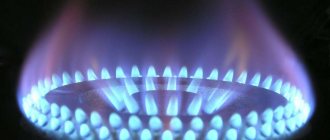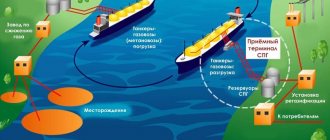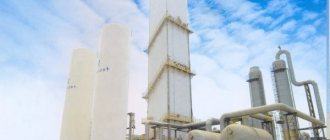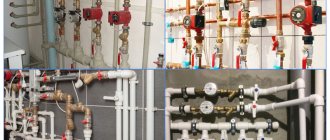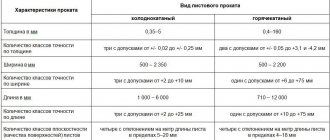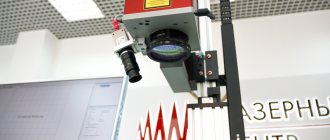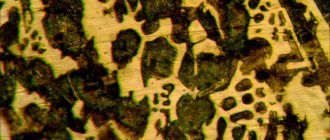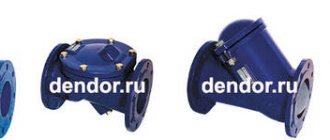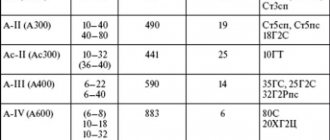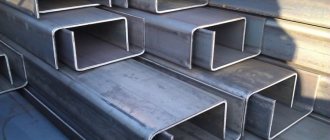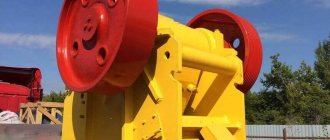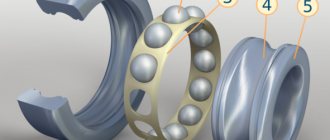Our country has many natural resources that are used as heating sources for houses and apartments. Among them are wood, coal, and hydrocarbons. Most of the tiles in city apartments are connected to the central gas supply, which supplies natural gas. This resource is environmentally friendly. It does not harm either people or animals. However, it is a dangerous source for people and their property, so fire safety regulations must be followed.
What is the normal flame temperature of a gas stove?
97-98 percent of the household gas mixture supplied to residents of houses consists of methane. There are impurities of sulfur, carbon dioxide and nitrogen in a minimal volume.
The interesting thing is that natural gas itself has no odor; it is neutral. The substance emillercaptan is specially added to it, which is completely safe for the human body and animals, but has a rather specific smell. A person will immediately feel this smell if methane begins to leak from tiles or through pipes, and he will be able to take appropriate measures.
Temperature distribution above the burner
The combustion temperature is determined by the set operating mode of the stove. The flame consists of different colors, each color indicates certain temperatures. Three main zones can be roughly distinguished:
- Blue flame zone – the combustion temperature here is in the range of 800 degrees;
- Orange flame zone - combustion occurs at a temperature of 1000 degrees;
- Yellow flame zone – temperatures here reach 1200 degrees.
As you can see, the fire in the red and yellow zones is hotter than the blue areas. At the top of the flame, which can be obtained through a gas stove, the indicator reaches 1400 degrees when the maximum combustion mode is set.
Gas combustion zones
The difference between propane and methane
Among the distinctive features of propane it is worth noting:
- higher combustion efficiency, making it much more efficient than methane during welding;
- high inertness of the gas, which allows it to more actively enter into various chemical reactions;
- propane is safer than methane and has a narcotic effect;
- When transporting propane, you do not need to use any special equipment; ordinary steel cylinders are sufficient.
In addition, propane is cheaper and easier to refill.
A value of 1800 degrees is ideal, for example, for welding metal workpieces, as well as for calcination, warming up in winter, or burning out individual sections of pipelines. For light alloy wheels and metals, you just need to choose a burner that can provide a directed effect.
But for other purposes this temperature may be excessively high. Therefore, we suggest that you follow the recommendations below:
- For processing wood, a temperature of 700-800 degrees will be sufficient. Such a flame will allow you to successfully cope with wood burning and decorating wood products, kindling wood on a barbecue, in a fireplace or in a stove.
- The maximum flame temperature is not required for working with glass, quartz, porcelain products, as well as with workpieces made of polymer materials. In addition, to process them, the flame must be directed and very thin.
- A minimum temperature of 200-350 degrees is ideal for cooking on a camping trip or in the field. In addition, you need to set it to this value if you want to process poultry carcasses, create some original decoration for desserts, or give a dish a more pleasant color.
What determines the combustion temperature of a gas?
The indicator depends on a number of factors. The greatest influence is exerted by the chemical composition of a particular mixture and the intensity of the fuel supply.
Effect of fuel
In apartment buildings, stoves that run on regular natural gas are most often installed. It is supplied through a central pipe to each individual apartment. But the substance is extracted under natural conditions. Consists of 97 or 98 percent (depending on composition) methane. Additional parts are sulfur, nitrogen, carbon dioxide and more. The average combustion temperature fluctuates around 700-800 degrees.
Gas can also be used without a central gas pipeline supplied by government services. In this case, it is supplied in a special reduced form in cylinders. This is a completely different gas in terms of its components: up to 8 percent butane, and the rest is propane. Moreover, the maximum combustion temperature of such a substance does not exceed 1000 degrees.
Gas mixture in cylinders
Influence of combustion mode
The intensity of combustion also affects the temperature. As described above, the flame is structured, and the color of the edges is determined by temperature. Using knobs or levers, the user of the stove regulates the intensity of the fuel supply. If you set it to maximum mode, the flow increases, and therefore the temperature. Otherwise, the opposite happens. If you choose low heat, most of it will only be blue (800 degrees). Medium heat is a mixture of blue and orange. In this case, the temperature will reach 1000 degrees. With a strong supply, yellow will prevail, the temperature of which reaches 1200 degrees Celsius.
In addition to ordinary tiles, threaded or collet-type burners, powered by a gas cylinder, are also used to produce fire. With their help, not only cooking and obtaining boiling water is carried out, but also various works on wood or metal, and smelting. Temperature indicators depend on the composition of the mixture that is used in the can itself.
Slow fire High fire
Temperature conditions and compatibility of the burner and cylinder
When the gas runs out, the cylinder is replaced with a new one suitable for this device. The compatibility of the burner and the cylinder is determined by the connectors, and here several connection options and temperature conditions are possible.
Compact model for lovers of outdoor recreation Source fonarik.com
Threaded
When comparing different types of gas burners for a can, which one will perform better in operation, many settle on threaded models. A popular connection method is when the burner is screwed onto a threaded cylinder; The connection can be made directly or through a connecting hose.
The threaded method is common because it is convenient: it allows you to regulate the supply and not use the entire gas mixture at once, ensures even, directional combustion, and is protected from gas leakage. If the burner is compatible only with threaded cylinders, then when switching to a collet cylinder, you must purchase an adapter.
The maximum operating temperature of threaded devices is 1800 °C, and they form a directed flame of a torch type. Some models allow you to regulate the supply of the gas mixture, and, therefore, the temperature and power of the torch for different types of work.
Model with temperature control for installation and construction work Source vellmart.net
How is the temperature on a gas stove determined?
In order to determine the combustion temperature of the gas in a specific stove, the easiest way is to find the instructions for it and read the information. But often, the equipment was purchased a long time ago or received from third parties, so the documents may not be preserved. It is not always necessary to know the operating parameters - all instructions for modern devices are available on the Internet. Gas stoves intended for domestic use have the following operating parameters:
- The maximum temperature that can be achieved on a household gas stove is about 280 degrees;
- Average heating – approximately 220 degrees;
- Operating mode with minimal fire supply – temperature 160 degrees.
To understand what the combustion and heating temperatures of certain liquids are, you can simply use knowledge from school physics. So, simple water without any impurities begins to boil at one hundred degrees. For regular unrefined sunflower oil to boil, you will need at least 200 degrees. Olive oil boils at a temperature of 250 degrees. Soybean and corn oil begin to boil at 150 degrees.
Boiling water
Specifications
To the question: “How are the chemical and physical properties related to the technical features of this mixture?”, it is worth considering all possible answers.
- Firstly, due to its high “holding” pressure in the liquid state, this gas is too inert. That is, it can easily be converted from a liquid to a gaseous state. This is a very useful feature in industries where this is absolutely necessary.
- Secondly, the low boiling and freezing points make the propane-butane mixture resistant to “collisions” with substances of nitrogen origin. Consequently, it guarantees its safety from freezing and boiling.
- And, of course, it is worth noting the high combustion temperature of propane, without which its benefits would not be so significant for achieving certain household or industrial goals.
Temperature of glass hob on gas
Improved gas stoves have appeared relatively recently. The operating technology of these hobs is based on the “gas under glass” technology. Its peculiarity is that the burners are located under special heat-resistant glass. This allows you to reduce the risks that are possible when using a gas stove, as well as make the design more interesting and modern, and fit the hob into the interior.
Such gas stoves have slightly different design features. There are no direct burners with an open flame. The burners are made of ceramic material and are located under a glass surface. Their type is catalytic. The convenience is that the chambers are sealed, which allows you to completely burn all the fuel without any residue. The work done by the gas is transferred to the ceramics. You can see the degree of its heating by small lights that are located under the glass cooking surface. Thanks to the advanced technology of this type of burner, it can heat up to 800 degrees Celsius, which allows you to cook new and unusual dishes.
Heat in such burners is supplied strictly vertically. There is a special contour that limits with other surfaces. That is, the gas does not escape beyond the heated circle, which allows heating only a localized surface. Only the bottom of the pan heats up, and not its edges, which often happens when using standard-type burners.
Glass hob
How does the type of fuel affect temperature?
Liquefied and natural gas are used for domestic purposes. Both types of fuel are odorized with ethyl mercaptan so that gas leaks can be felt when equipment malfunctions or a tap is opened. The basis of natural gas is methane, the amount of which is 98%, the rest is impurities of carbon dioxide, nitrogen and sulfur. Liquefied gas supplied in cylinders is used in the private sector where there are no main gas pipelines. Liquefied fuel consists of 65% propane and 35% butane.
The thermal efficiency of bottled gas is worse compared to natural gas, because the flame temperature is no more than a thousand degrees. For each type of gas they use their own gas appliances. When selecting equipment, the type of gas should be taken into account. To compensate for temperature differences and convert gas stoves to bottled fuel, special gearboxes and jets are installed.
What temperature is needed for cooking?
Different foods require different temperatures to cook. Heat treatment is especially important for meat and fish - due to insufficient temperatures, the products may not be cooked and harmful microorganisms will remain in them, which can cause health problems.
Often, recipes for dishes do not specify at what temperature the cooking takes place, so they rely on their own knowledge of the characteristics of the products and their heat treatment. The recommended temperature range is as follows:
- Cooking food – up to 98 degrees;
- Meat cutlets and steaks - from 190 to 230 degrees;
- Fried potatoes - up to 190 degrees;
- Stewing and frying defrosted vegetables - up to 130 degrees;
- Frying fish - up to 170 degrees.
The indicated temperatures for cooking are of a conditional nature. In practice, some changes are possible, which are determined on an individual basis.
All about the temperature of gas burners
- What does it depend on?
- What temperatures do different types produce?
- How to adjust?
Despite the great popularity of electric stoves and other similar electric heating devices, the use of simple gas burners still remains relevant both in everyday life and in production.
When using burners, few people seriously think about the flame temperature. However, it is precisely this factor that determines the scope of application of the burner. Read below for all about what the temperature of a gas burner depends on and how to regulate it, as well as many other interesting facts.
Technical propane: properties
Among the main parameters of the substance, it is worth noting the following:
- the sum of propylene and propane is at least 75% of the total volume (the amount of the latter is not standardized);
- the amount of butanes and unsaturated hydrocarbons is not standardized;
- the amount of liquid residue should not exceed 0.7% vol.;
- the saturated vapor pressure at a temperature of – 20 ◦C must be at least 0.16 MPa;
- the amount of hydrogen sulfide and mercaptan sulfur should not exceed 0.013% of the total volume;
- The intensity of the propane odor should exceed 3 points.
The minimum combustion temperature for propane is – 35 °C. Thanks to this, you can work with gas in any conditions. Propane ignites spontaneously at normal atmospheric pressure at a temperature of 466 °C. At 97 °C the critical temperature of propane occurs. The combustion temperature of propane-butane ranges from 800 to 1970 °C, the combustion flame of pure propane has a temperature of about 2526 °C, and the heat output, on average, is 2110 °C. In gas cutters, when mixed with oxygen from 1:4 to 1:5 (propane:oxygen), a flame temperature of up to 2830 °C occurs.
